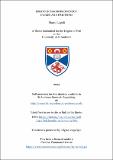Files in this item
Essays in macroeconomics : cycles and frictions
Item metadata
| dc.contributor.advisor | McCrorie, Roderick | |
| dc.contributor.advisor | Senay, Özge | |
| dc.contributor.author | Lupoli, Mario | |
| dc.coverage.spatial | 281 | en_US |
| dc.date.accessioned | 2023-06-30T15:36:53Z | |
| dc.date.available | 2023-06-30T15:36:53Z | |
| dc.date.issued | 2023-11-28 | |
| dc.identifier.uri | https://hdl.handle.net/10023/27865 | |
| dc.description.abstract | This thesis contributes to different literatures in macroeconomics with frictions. In the first two Chapters I consider imperfections in the credit market and how these can amplify monetary policy shocks. I start from a purely empirical model, which identifies monetary policy shocks and then I develop a structural model with an explicit market for mortgage loans intermediated by a banking sector. Households and banks are each facing a different optimisation program. I show that this model better captures the volatility of macroeconomic aggregates than alternative frictionless cases. This richer modelling setting assigns a more complicated role to the monetary authority, as the policy rate influences asset prices, nominal debt and bank profitability in addition to intertemporal consumption. The Third Chapter is concerned with wage rigidity and how to measure it. We define it as relative to the wage one would expect under Nash bargaining. Then we develop a statistic for wage rigidity, the Nash Wage Elasticity (NWE) by regressing actual wages on the Nash bargained wage. Most of our calibrations yield a NWE between 0 and 0.1, signifying that actual wages are very rigid and that the Nash wage is a poor description of the business cycle. We calibrate a search and matching model to match our estimated NWE, showing how this modification translates into greater cyclical fluctuations. In the fourth Chapter I analyse the causal relation linking index investment to commodity future prices. I show that standard Granger causality results cannot be taken at face value given the extraordinary movement in prices during the Great Financial Crisis. I apply instead a Time-Varying Granger test apt to gauge the evolution of the causal relation, showing how future prices are endogenous to index investment flows at particular points in time, generally supporting the hypothesis of financialization in the commodity market. | en_US |
| dc.language.iso | en | en_US |
| dc.rights | Creative Commons Attribution-NonCommercial-NoDerivatives 4.0 International | * |
| dc.rights.uri | http://creativecommons.org/licenses/by-nc-nd/4.0/ | * |
| dc.subject | Monetary policy | en_US |
| dc.subject | DSGE | en_US |
| dc.subject | Structural VAR | en_US |
| dc.subject | Leaning against the wind | en_US |
| dc.subject | Granger causality | en_US |
| dc.subject | Shimer puzzle | en_US |
| dc.subject | Nash wage elasticity | en_US |
| dc.subject | Monetary surprise | en_US |
| dc.subject.lcc | HB172.5L8 | |
| dc.subject.lcsh | Macroeconomics | en |
| dc.subject.lcsh | Monetary policy | en |
| dc.title | Essays in macroeconomics : cycles and frictions | en_US |
| dc.type | Thesis | en_US |
| dc.contributor.sponsor | Economic and Social Research Council (ESRC) | en_US |
| dc.type.qualificationlevel | Doctoral | en_US |
| dc.type.qualificationname | PhD Doctor of Philosophy | en_US |
| dc.publisher.institution | The University of St Andrews | en_US |
| dc.identifier.doi | https://doi.org/10.17630/sta/528 | |
| dc.identifier.grantnumber | ES/P000681/1 | en_US |
The following licence files are associated with this item:
This item appears in the following Collection(s)
Except where otherwise noted within the work, this item's licence for re-use is described as Creative Commons Attribution-NonCommercial-NoDerivatives 4.0 International
Items in the St Andrews Research Repository are protected by copyright, with all rights reserved, unless otherwise indicated.


